Noellynn Slaughter Despite two decades of US led counterterrorism efforts since 9/11, terrorism has continued…

THE HYPNOTIC POWER OF ISIS IMAGERY IN RECRUITING WESTERN YOUTH
A picture is worth a thousand words. It’s a commonly accepted piece of wisdom—one that groups like al Qaeda and ISIS understand all too well when trying to recruit Western youth into their ranks. Images often speak directly to our right brains, activating the limbic system, and potentially bypassing rational thought. This results in statements that are subtly, or overtly embedded, alongside emotionally evocative images, highly suggestive—if not downright hypnotic.
Both al Qaeda and ISIS have built their terrorist narrative upon hijacked verses from sacred scriptures of the Quran and hadiths arguing that militant jihad is a duty incumbent on all Muslims. After declaring its Caliphate in Iraq and Syria, ISIS declared even more strongly than ever before, that hijrah—or moving to the battleground—is also incumbent on all Muslims, and for those Westerners who cannot come, one is enjoined to “stay and attack” at home. This was an argument put forward in English years earlier, prior to ISIS even being formed, by Anwar al-Awlaki (of al Qaeda in the Arabian Peninsula).[1] Although al-Awlaki was killed by a U.S. drone strike in 2011, he continues to inspire from beyond the grave—enjoying eternal life over the Internet via his preserved sermons of hatred for the West.
Al Qaeda argued early on, and ISIS has taken up the same line of reasoning, that the worldwide Islamic jihad is a defensive one, a line of argument that is made by showing graphic images and video from conflict zones to demonstrate undisputed tragedy. The West in militant jihadi propaganda, is held responsible for propping up tyrannical dictators, states; and in places like Afghanistan and Iraq, even overtly invading Muslim lands, hurting Muslim people, and attacking Islam itself. As a result, these groups call for so-called “defensive” jihad.
In its propaganda, ISIS defends its savagery and bloodshed as a necessary evil. Its leaders and ideologues argue that building the Caliphate involves a worldwide revolution to bring in a new utopian system to rule according to Islamic ideals and that all revolutions require blood to be spilled. Abu Baker al-Baghdadi, seeming to understand that gruesome savagery was not perhaps the best marketing tool, did however, recently order that graphically violent images and videos of the group’s atrocities no longer be posted, in favor of videos that demonstrate successes of the Islamic State in building a new, peaceful, and well-running society. [2]
While one would hope that Westerners would be capable of critical thinking and not easily succumb to the visual propaganda of groups like ISIS, we know that other enterprises such as business like Coca Cola (Share a Coke) and Nike (Just Do It), and humanitarian missions like World Vision (starving child surrounded by flies) also successfully use imagery coupled with catchy slogans in much the same way—to bypass critical thinking and engage emotions to gain a sale, or in the case of humanitarian organizations, a donation.
ISIS is no different in that regard. An examination of the propaganda imagery found in Internet posters, videos, and media campaigns demonstrates the same use of images and emotional appeals as that used so successfully in Western advertising. The following is an analysis of some of their emotional and visual appeals of materials produced by al Hayat Media Center, the media arm of ISIS, and Rayat al Tawheed, a group of British foreign fighters representing ISIS.
Belonging
Human beings are a social species. Relatedness and belonging in youth to one’s parent, if not larger family, determines our survival and ability to thrive. In adulthood belonging to groups often greatly influences our level of psychological, economic and social wellbeing.

As a religion, Islam accepts people of all colors and ethnicities, although Arabs themselves have not always been free of ethnic prejudices. This inclusivity of Islam is now something that ISIS touts as a positive for joining their terror organization.
We are all ISIS is a slogan that ISIS uses in various posters, and even on t-shirts, to try to marry the inclusivity of Islam and the idea that all Muslims belong to the larger ummah, or family of Muslims, with the so-called duty to make hijrah and come to fight militant jihad with ISIS—to restore the Caliphate.
According to the ISIS propaganda campaign, if one is Muslim, one also belongs to ISIS. The critical thought that is overridden is to overlook that one must become a jihadi fighter, or marry one, to “belong” to ISIS and the call is not just to Islamic belonging, but also to sectarian and terrorist violence.

The We are all ISIS slogan has appeared on t-shirts and other gear marketed to Muslims who might (literally) buy into the idea that ISIS includes all believers.

Call to the Battlefield
One ISIS poster shows the tip of an assault rifle in the window of a vehicle as it passes a London city bus. The slogan reads, Sometimes You Just Got to Get Up and Go. The meaning is clear, recalling al-Qaeda attacks on the London transport system and the call to get up and go—either to the battlefield to join jihad or to attack at home. Impulsive responsiveness—overriding critical thinking—is implicitly praised.

In the 2014 ISIS film There is no Life Without Jihad, a former medical student from Cardiff, Nasser Muthana, argues for the inclusivity that ISIS is creating as it tears down borders erected by former colonial powers: “We are a state who is implementing the Sharia in both Iraq and the Sham. And look at the soldiers, we understand no borders.” He goes on to claim, “We have participated in battles in Sham and we will go to Iraq in a few days and we will fight there. We will even go to Lebanon and Jordan with no problems, wherever our Sheikh [al-Baghdadi] wants to send us. We have brothers from Bangladesh, from Iraq, from Cambodia, Australia, UK. Nothing has gathered us except to make Allah the highest. That’s all we’ve came for… We have people from all over the world willing to help.”
By calling all nationalities to come to the newly declared Caliphate and that borders are being torn down, Muthana is trying to promote the idea of ISIS as inclusive, and that their group will ultimately result in world domination. [3]

Another video, entitled The End of Sykes-Picot, shows an ISIS fighter standing on, and crossing over the border between Iraq and Syria as he proclaims, “We don’t recognize [the border] and will never recognize it. God willing, this is not the first border we will break, we will break all the borders as well.” [4]
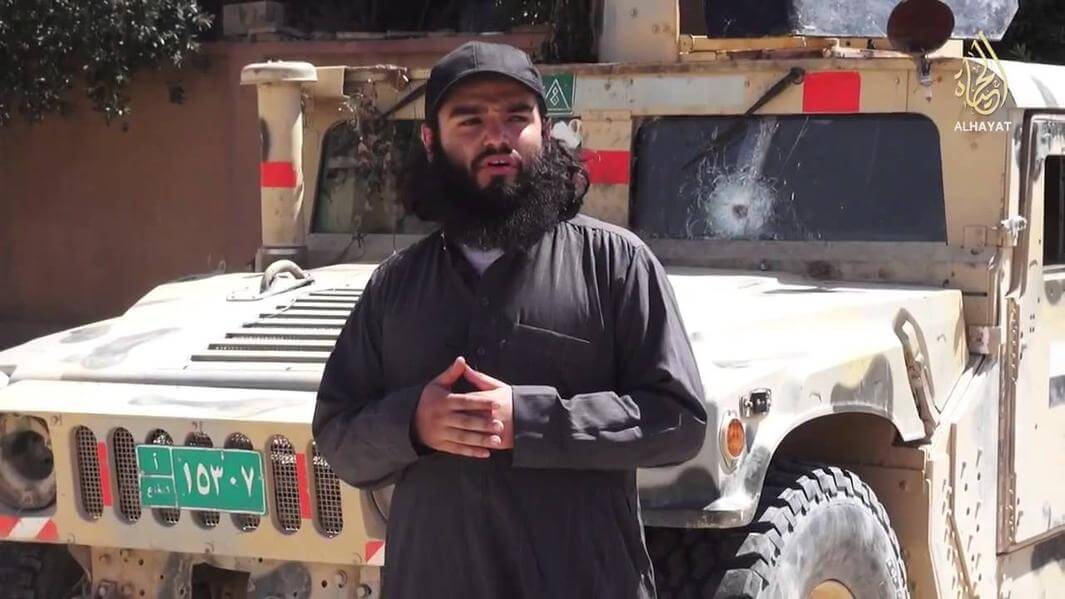
That particular border being opened between Sham and Iraq is also mentioned in End Times prophesies (in the hadith of Saheeh Muslim) that predict the anti-Christ to ultimately appear on the road between Iraq and Syria.

That ISIS cadres opened this border with a road can be taken as an important harbinger to Muslims who may see that as a sign to believe that ISIS is ushering in a new, final age and that their declared Caliphate is indeed legitimate. [5]

Duty & Obedience
ISIS propaganda argues persuasively, as did al Qaeda media predating it, that Muslims have a duty to respond to the call to militant jihad. The most persuasive ideologue for these arguments in English was, and continues to be Anwar al-Awlaki, whose continued Internet urging of Western Muslims into jihadi groups and terrorist actions as a core component of their Islamic duty makes his sermons to be one of the most likely downloads to be found on the computers of English speaking ISIS and al Qaeda inspired terrorists. His soft voice and intelligent eyes belie a message filled with hatred for the West.

Among the group of terrorists he is credited with having inspired, most simply through his Internet teachings, are the Toronto 18—a group of sixteen Canadians and two Americans, that plotted to place explosive-laden trucks having the same blast power of the Oklahoma City bombs around Toronto and also plotted to storm the Canadian Parliament and behead their Prime Minister. Their American cadres had their sites set on the U.S. Capitol. The group members were ardent al-Awlaki followers. [6] Nigerian terrorist, Umar Farouk Abdulmutallab, the so-called “underwear bomber,” who tried to take down a flight over Detroit on Christmas day of 2009 was also in direct contact with al-Awlaki and may even have been under his command.
The Tsarnaev brothers, also known as the Boston bombers, bought into al-Awlaki’s virulent ideology and were loyal fans. So too were the London metro bombers. Nidal Hasan, an Army psychiatrist, and follower of al-Awlaki’s teachings, was in direct contact with him by e-mail before he registered his displeasure with American actions in Afghanistan and Iraq by carrying out a massacre at the Fort Hood Army base in Texas. Hasan’s murderous actions were later praised by al-Awlaki. Mohammad Youssef Abdulazeez, the July 2015, Chattanooga shooter who attacked military recruiting stations in the U.S. also downloaded and was a fan of al-Awlaki’s sermons. Roshonara Choudhry, the Kings College honors student who stabbed a UK Parliamentarian for voting for invading Iraq, as well as Shannon Conley, the recently sentenced Denver, Colorado wannabe ISIS bride were devotees of al-Awlaki.
As al-Awlaki moved from endorsing resistance to preaching hatred, particularly for the United States, he argued that a core requirement of Islam is to take “hijrah” and fight jihad—that is move to the battlefield and engage endlessly with the so-called enemies of Islam until the End Times. According to al-Awlaki, for the Muslim this is an obligation, a core duty, and there is no excuse not to fight, and it must go on forever and ceaselessly until Islam is victorious—basically until the End Times.
ISIS propaganda builds on these ideas already well spun by al-Awlaki and they often praise him in their writings. One poster, showing a fighter shooting from a weapon held on his shoulder, urges the viewer, Respond to Allah and his Messenger implying that fighting militant jihad is a holy and religious duty.

A similar one has the same message with another fighter armed with ammunition and a machine gun.

In one poster, both the Quran and a weapon are depicted while asking believers, Has not the time come for the hearts of those who believe to be affected by the reminder of Allah. This part of the Quran speaks of the hardening hearts of Christians and Jews who, according to Islamic scriptures, turned disobedient and rebellious, and it urges Muslims to do otherwise and submit obediently. In this propaganda piece, however, the implied obedience is to the call to militant jihad.

Another poster shows an ISIS fighter, his rifle slung over his back as he walks through what appears to be a Syrian city. It quotes from the Quran to remind the viewer what Moses (Musa in Arabic) said when confronted with the much greater military force of Pharaoh trying to turn Musa, and his followers, back into slavery—My Lord is with me and He will guide me. The implication is that the ISIS cadre roaming the Syrian streets with his rifle is freeing himself from tyranny and is standing up to a much greater and evil force with the help of Allah on his side. And if one recalls the miracles granted to Moses, then victory should be close at hand—no matter the odds.

Honor & Glory
In the same way ISIS propaganda depicts the religious call and duty to jihad it also predicts the future victory of the group. One poster, constructed like a movie advertisement proclaims a new release—Prepare for Glory which is made to look like an epic film from gladiator days with ISIS cadres battling U.S. and Iraqi soldiers, who are depicted being pitched off a cliff by ISIS cadres wielding shields and long spikes forcing them into bloodied deaths.

The credits read: The Islamic State in Sham and Iraq presents in association with Abu Bakr al-Baghdadi and Abu Muhammad al-Adani a Sheik abu Mus’ab al-Zarqawi production, Produced by Sheik Usama bin Laden. At the end it reads, Coming to a Tyrant Near You. The idea being that ISIS under the leadership of al-Baghdadi and its spokesman al-Adani will carry out what al-Qaeda in Iraq began under al-Zarqawi’s leadership, following the lead of Osama bin Laden—defeating both the U.S. and Iraqi military forces.

Another poster shows an assault rifle placed over an ammunition vest with the slogan Caliphate Special Forces. The idea being that the Caliphate also has Special Forces with the implication that the reader should join up.
Many posters and videos also claim that the Islamic State and the Caliphate have been established.

Most show ISIS fighters proudly and jubilantly depicted alongside this claim.

Collective Identity
ISIS not only capitalizes on the concepts of belonging, duty, and honor but also on Muslim collective identity.

One poster depicts an armed ISIS soldier overlooking the al Aqsa mosque in Jerusalem with the slogan, We Haven’t Forgotten.
Another shows the ISIS flag flying over al Aqsa mosque while declaring Khilafah [Caliphate], The March Toward Jerusalem. The message is clear—the Caliphate is declared and Muslims will retake Jerusalem.

Many of the posters declare the Caliphate has been established for those who follow Muhammad.
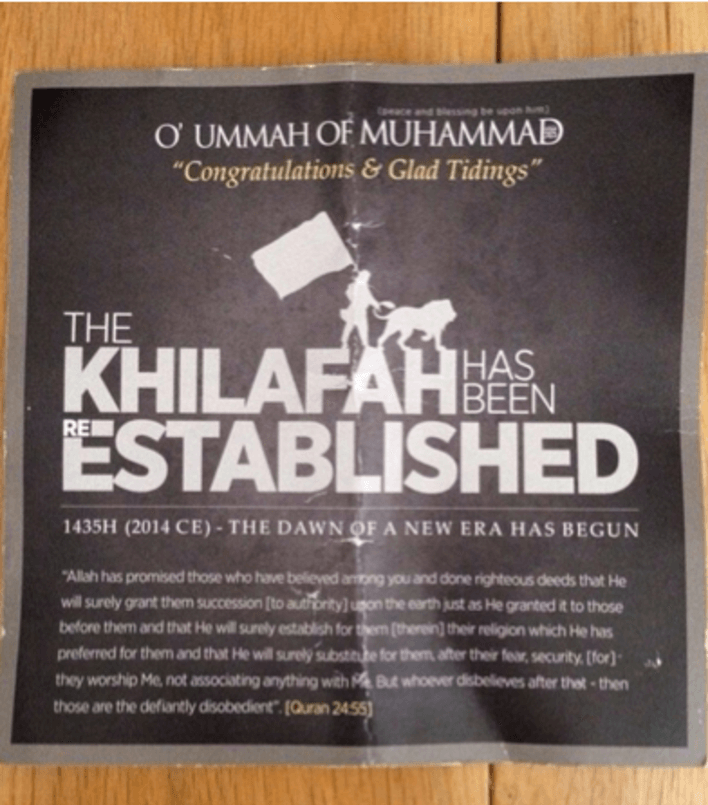
Others celebrate the future breaking down of borders and dominion over cities like New York and Washington, D.C. in efforts to show a positive new identity—of the Muslim ummah dominating the world. This one shows the ISIS flag flying in New York City.
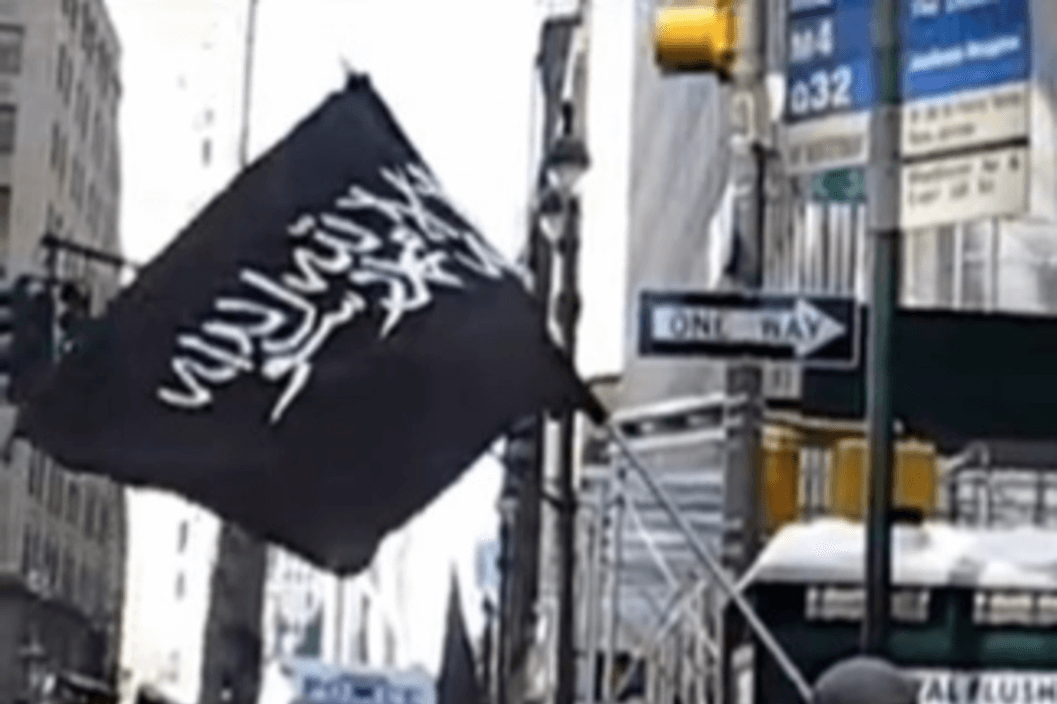
Popular icons are also overtaken with ISIS flags. For instance the Facebook “Like” becomes a thumbs up holding an ISIS flag.

Similarly, the Twitter bird icon becomes black, and sports the ISIS symbol.

The U.S. Pledge of Allegiance which starts with the words, “I Pledge Allegiance” are used as a slogan for the Muslim Defense Force depicted with two Islamic flags.

Bolstering Male and Female Gender Stereotypes
A common developmental task of young people is to achieve a suitable match with cultural gender stereotypes to attain a positive sense of gender identity. In Western cultures this is no small feat, particularly when the demands for gender conformity are as contradictory as they are in Western culture—particularly for the religiously conservative. For instance a young, Western woman may struggle along a tightrope of feeling demands to appear as a wanton sex object while also trying to self-actualize as a smart, independent, young women capable of making her own way in the world. As she prepares for roles in the workplace, as well as future motherhood, she may also experience anxiety as the role requirements are often contradictory in their demands for time, attention, and development of specific traits necessary for success. ISIS simplifies all that for women promising them that they will be well taken care of, married, and expected to raise a family all while being covered and sheltered by their husbands.
Bird of Jannah, a Malaysian bride of ISIS, writing on Tumblr, describes and put up captioned images that depict her claims about the romantic side of becoming an ISIS bride.
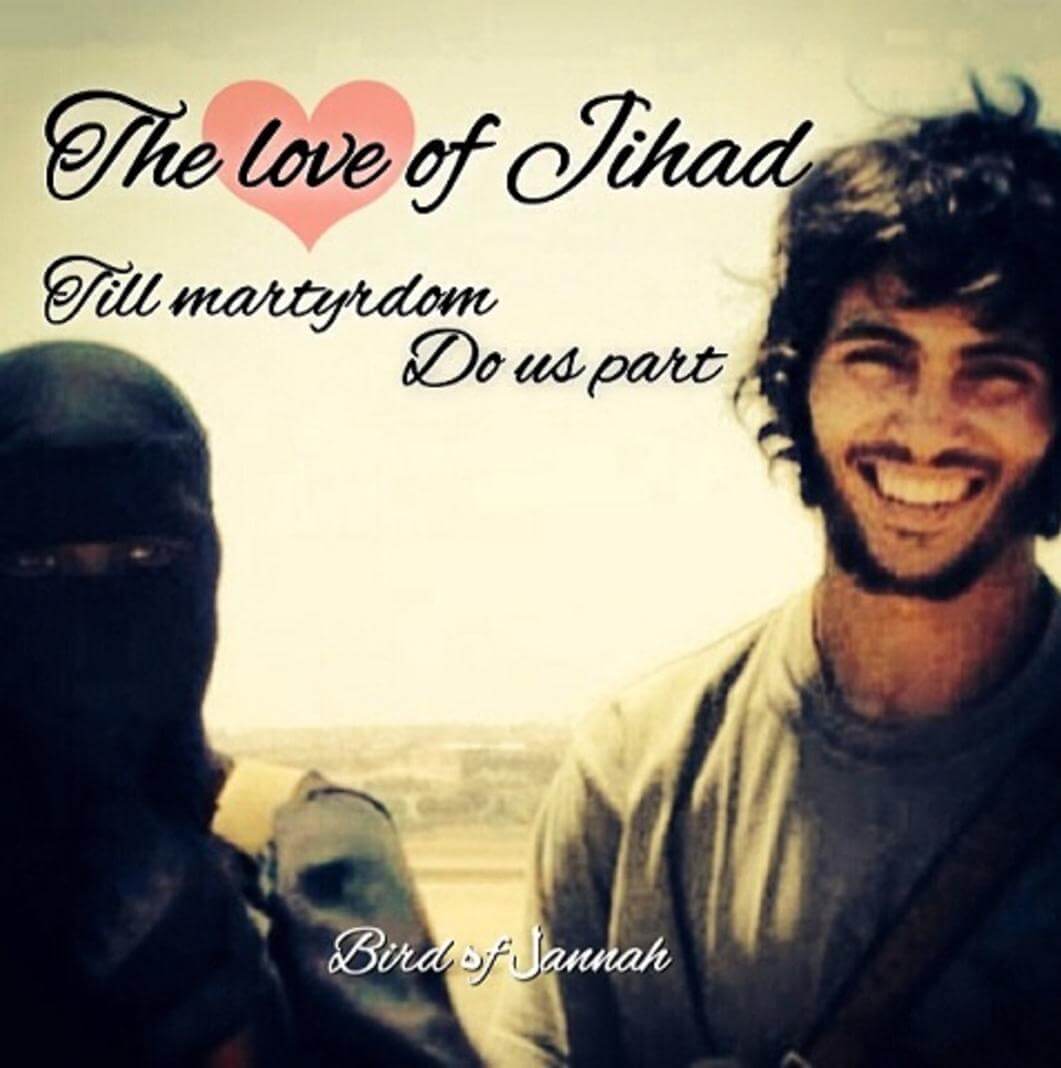
One of her photos, showing her fully covered alongside her widely smiling ISIS husband bears the caption, The love of Jihad, Till martyrdom Do us part. Bird of Jannah by her own accounts married an ISIS fighter through an arranged marriage and didn’t share a common language with him. They communicated in the first days using dictionary apps on their phones. [7]
Another poster she placed on her blog is of a young couple with a romantic heart at their feet, captioned, And in the land of Jihad I found you…Oh my Dear Mujahid [Islamic Warrior]. The implication being that by joining ISIS a woman can find true love.

Another ISIS poster aimed at women depicts a woman in a full niqaab and burka shooting a rifle with the slogan, Islam has made me free. While many would argue that females are hardly “free” inside ISIS, the propaganda is that they are freed of the constraints of Western society and able to live in the utopian state they are helping to build.

Many ISIS pictures with women show them with material belongings—new cars or having fun training with guns, obviously enjoying their female fellowship together.
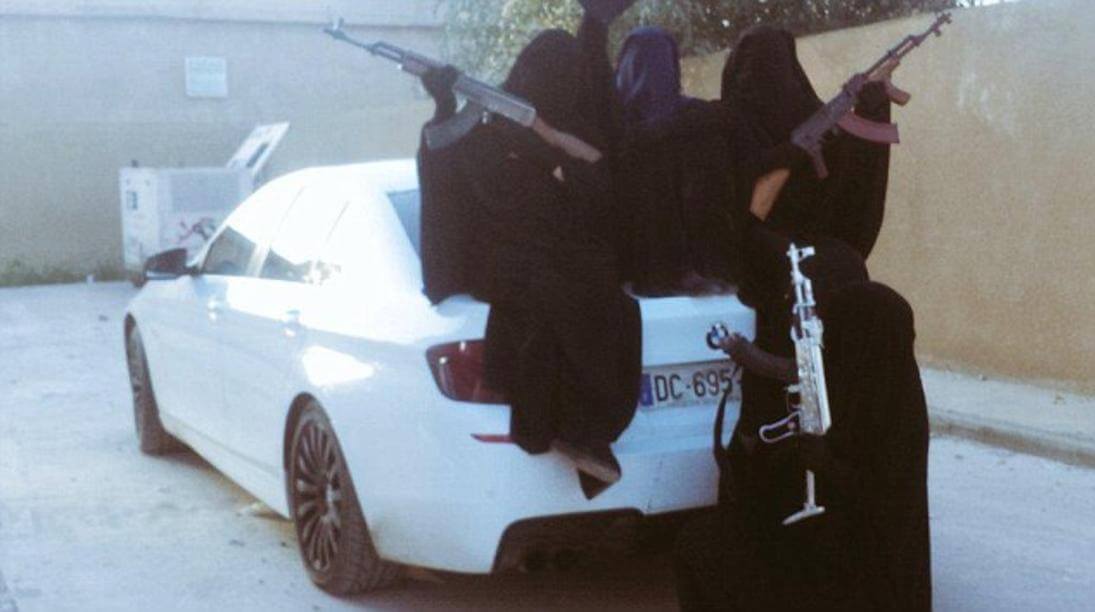
Zehra Duman, a female ISIS bride from Melbourne, Australia for instance posted this photo with the media caption, 5 Star Jihad. M5 in the land of Sham,he he. She was alluding to the BMW the women were seated upon implying that life is good for women in ISIS.
Young males have a similar struggle trying to conform to male gender stereotypes. Whereas menstruation is solid proof to a young woman that she can likely fulfill at least one female adult stereotype—of becoming a mother; young men—particularly those who have been bullied, whose bodies don’t conform with the typical male role models of the day, who can’t find employment, and who are otherwise failing to live up to male stereotypes may grasp at traits they believe bolster their manhood and resonate to groups that promise them a path to manhood.
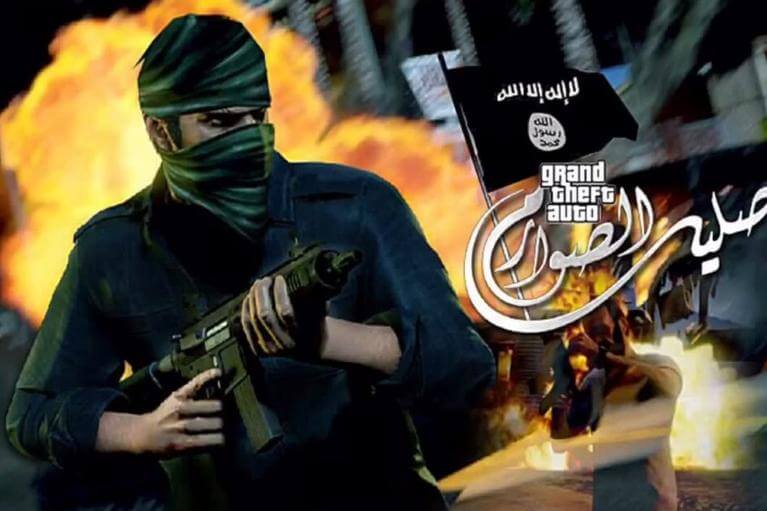
Young men often identify strongly with the male role models and the masculine stereotypes promoted in the video games they play and ISIS is well aware of that. They have used both graphic still photos and videos taken from such video games as Grand Theft Auto and Call of Duty to try to mesh their message with the messages of “maleness” embedded in such games. Likewise they urge young men to get out from behind their video controllers and come join the “real games” in partaking of jihad. In the hijacked video from Grand Theft Auto, the ISIS narrator states, “Your games which are producing from you, we do the same actions in the battlefields!!”

This poster shows two ISIS fighters, one with his finger raised depicting the belief in only one God, as Call of Duty fighters. Its caption: This is our Call of Duty and We Respawn in Jannah. The suggestion is that to become an ISIS fighter is to respond to the duty of all real men to fight for righteousness, and that just like in video games, death is nothing to be feared nor permanent. The ISIS fighter revives, just like the game avatars, although the “afterlife” of the ISIS fighter is in jannah, i.e. Islamic paradise.
While some have argued that Islam is a violent religion or that Islamic culture is inculcating the cultural values that young men have a duty to fight, one former extremist argues that it may be just the opposite—that Western values, particularly American cultural mores for young men may contribute equally to the belief that to be manly one should be willing to take up arms for oppressed peoples. American and Catholic raised, Michael Muhammed Knight who nearly went to fight jihad in Chechnya writes about what motivated him to fight for oppressed peoples: “It wasn’t a verse I’d read in our Qur’an study circles that made me want to fight, but rather my American values. I had grown up in the Reagan ‘80s. I learned from G.I. Joe cartoons to (in the words of the theme song) “fight for freedom wherever there’s trouble.” I assumed that individuals had the right—and the duty—to intervene anywhere on the planet where they perceived threats to freedom, justice and equality… Like so many Americans moved by their love of country to serve in the armed forces, I yearned to fight oppression and protect the safety and dignity of others.” [8]

Rayat al Tawheed, a group of British foreign fighters representing ISIS put out a poster captioned, Real Struggles Need Real Men playing upon exactly this sentiment—that real men fight against oppression. Another is captioned Real Men are Known in Times of Hardship. Of course both feature ISIS fighters equipped with weapons.

Another poster plays on the idea of male fearlessness in battle. It features a male ISIS fighter shooting a high-powered rifled and is captioned, Cowardice Will Not Increase my Life.

Another poster is simple. It shows the Islamic black flag, two crossed swords and a lion, implying strength and manhood in jihad.

Mubin Shaikh, a Canadian and now reformed extremist, found that it wasn’t Western values that laid the foundation for his attraction to extremism, but his inability to form his identity between the tension of Western values and what he learned in the Islamic madrasah where he studied nightly as a young boy in Toronto alongside a strict conservative Muslim upbringing. Shaikh found himself strongly attracted to Islamic ideals of manhood that he found portrayed in Taliban cadres he met by chance while on an Islamic mission trip in Pakistan. Powerfully raising an AK-47 above his turbaned head, a Taliban soldier told Mubin, “Jihad is how you change the world.” Reflecting later, back in Canada, about the impression made upon him, Mubin saw indeed that the Taliban had managed to take control of Afghanistan. In his mind, these Taliban soldiers, muscular, sun-tanned, wielding weapons, and dressed in strict Islamic style, appeared like manly incarnations of the glorious Muslim Sahaba, the original Companions of the Prophet, that he had learned about as a young boy in Islamic school—and he desperately wanted to be like them. As a result he ventured into militant jihadi groups and even moved to Syria for some time.[9]
Whether it’s American or Islamic ideals of masculinity, both are powerful motivating forces to move a young man struggling with consolidating his male identity into considering joining a group like ISIS.
Females Motivating Males
There have been many claims that young men are willing to “martyr” themselves to attain the seventy-two virgins promised them in Paradise. In my interviews with over four hundred terrorists, their family members and close associates, I have rarely found “the virgins” to be much more than a comfort at the idea of death. However, the promise of sex now, is highly motivating. [10]
ISIS promises young male cadres that they will be married to jihadi brides and also enjoy the “bounties of war”—young Yezidi slaves to be enjoyed by ISIS fighters. In both of these instances, the young man believes he will be attaining sex now, not in the afterlife, although if he’s “martyred” he may also hope to attain the virgins.
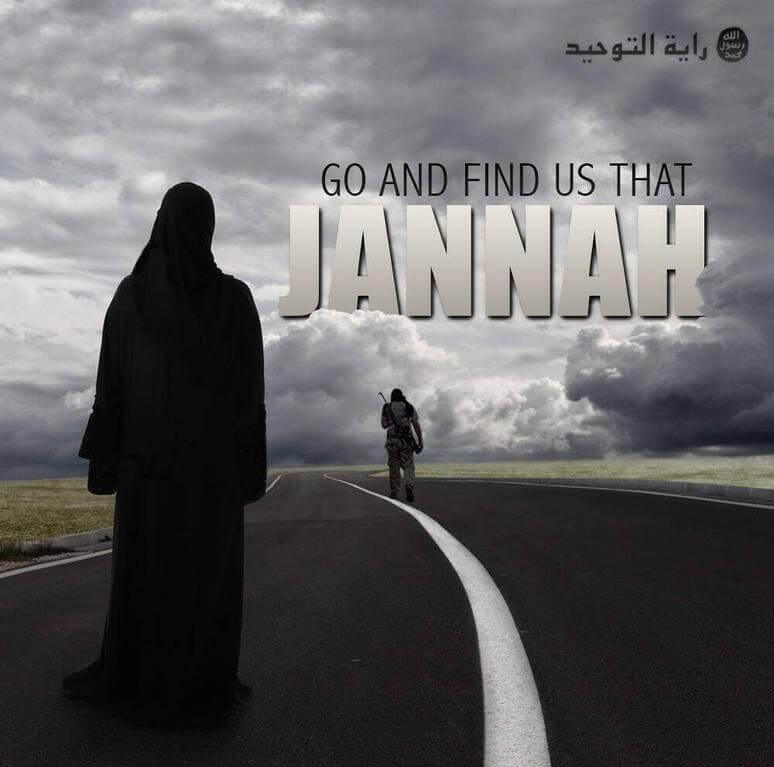
One poster depicting a woman in her burqa, encouraging her man is captioned, Go and Find us that Jannah. He by contrast is clothed in military camis as he walks away down a lonely highway with his rifle and pack slung over his shoulder. The implications being that she is his support and he will be attaining Paradise for them both through his jihadi fighting and “martyrdom.”
Existential Angst
Alongside consolidating one’s gender identity, young and old alike must contend with existential anxiety over the inevitability of death. Muslims in particular face a belief system that leaves it open as to what exactly will happen at death, yet they firmly believe in an afterlife. According to the Quran, all humanity will face a final judgment in which their sins will be weighed against their good deeds. Islamic visions of paradise are beautific, whereas hell and damnation are horrific, and of course anxiety producing for the believer—particularly the believer who has sinned in any serious manner.
The only way to guarantee one’s salvation aside from weighing one’s good deeds over one’s sins is to die a “martyr’s” death. ISIS and al Qaeda cash in on this angst by promoting just that.
This poster, with the caption of YODO, plays upon the common phrase of “you only live once,” implying you should make the most of your life. ISIS flips this positive message on its head. Instead, the Muslim reader is reminded, You only die once, and challenges: Why not make it martyrdom?

This poster with the caption, Sometimes people with the worst pasts create the best futures speaks to the possibility of redemption. It also has an explanation tacked on the top that reads, Jihad is a purification no matter who you are or what sins you have, no good deeds are needed to come before it. Don’t let nothing hold you back. The idea is basically that one can be redeemed, purified and have all sins washed away by joining ISIS and taking part in militant jihad.

Glorifying Death
Taking off on the “martyrdom” ideology many of the ISIS posters also glorify death. For instance one poster, featuring a fighter manning a machine gun and pointing his index finger skyward, is captioned, If Death is What you Offer Us then Know, We Came to Die.

In response to coalition airstrikes, an ISIS poster was created with the caption, Oh You Who Attack from the Skies, Below you are Men who Would Give their Lives a Thousand Times Over. Again the message is glorifying the courage to die for one’s cause and the fearlessness created by belief in a glorious afterlife for those who are “martyred”.

In their jihad against Russia, the Chechens used the battle cry of “Victory or Paradise” meaning that they would fight to the death—which they did, booby- trapping themselves into exploding buildings if surrounded by Russian forces and embracing “martyrdom” as a glorious way to die. [11] ISIS, a group heavily populated with Chechen & Dagestani fighters, has evidently picked up on the Chechen slogan, as one of the stills from a June 2014 al Hayat video is captioned, Either you get Victory… implying that Paradise is its alternative.
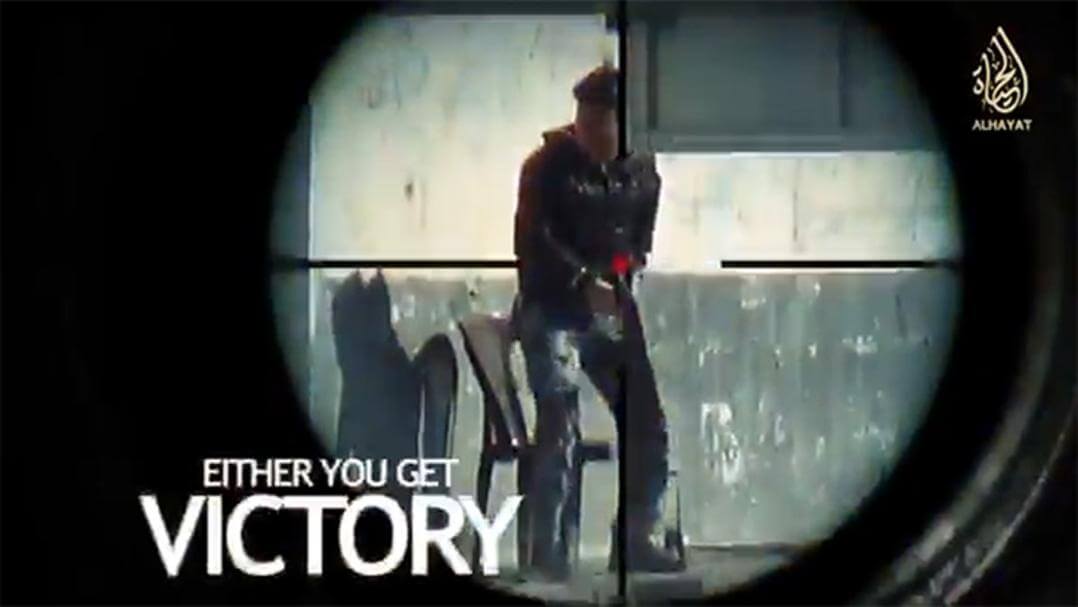
While many in the West expected foreign fighters from the West to get disillusioned and want to return home, and indeed—some have, ISIS has an answer for that as well. One of their posters asks, Why would we want to leave when Paradise lies ahead?
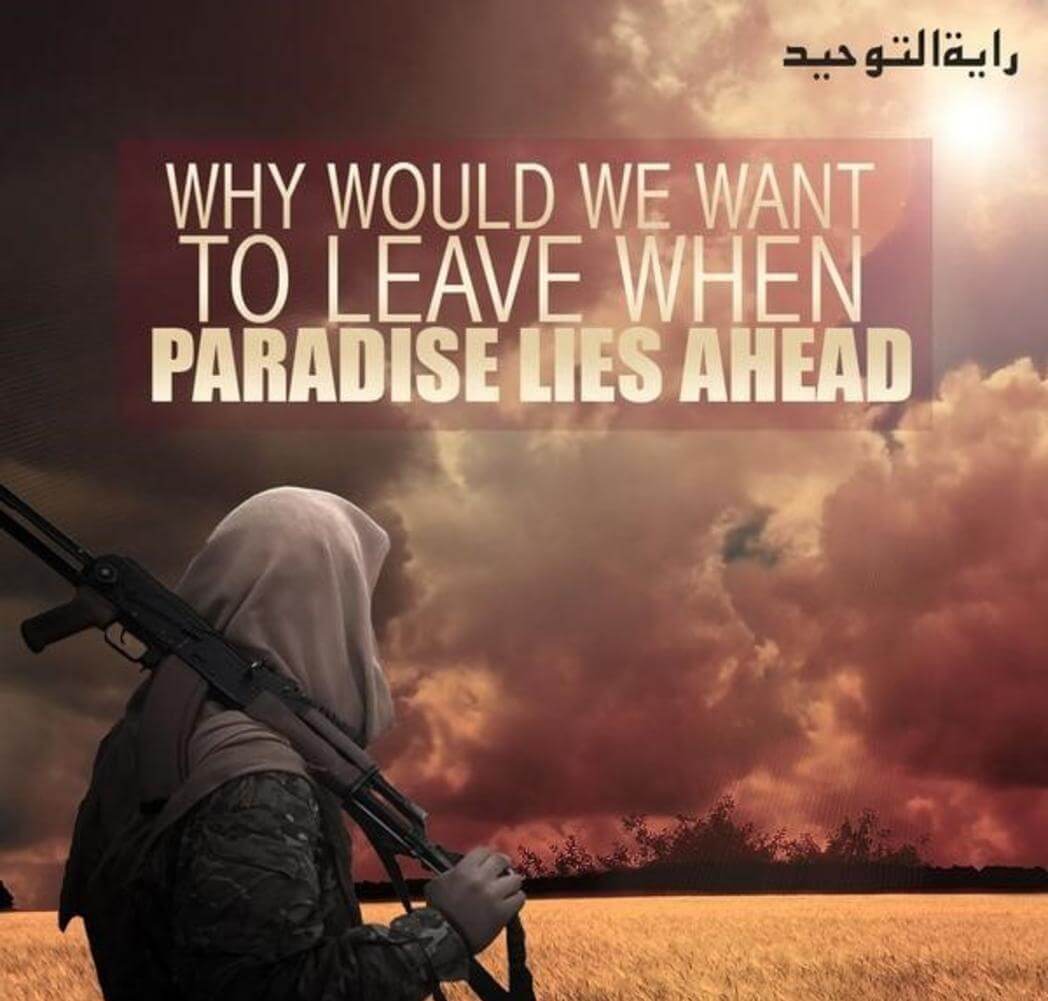
Oftentimes revered teachers are quoted, such as in this poster where Hasan al-Basri, one of the most important teachers of early Islam is quoted saying, Every Path has a Shortcut, the Shortcut to Jannah is Jihad. The steps showing the shortcut notably have blood staining them and the meaning is clear—that joining ISIS and taking up militant jihad will lead one on the quickest route to Paradise.
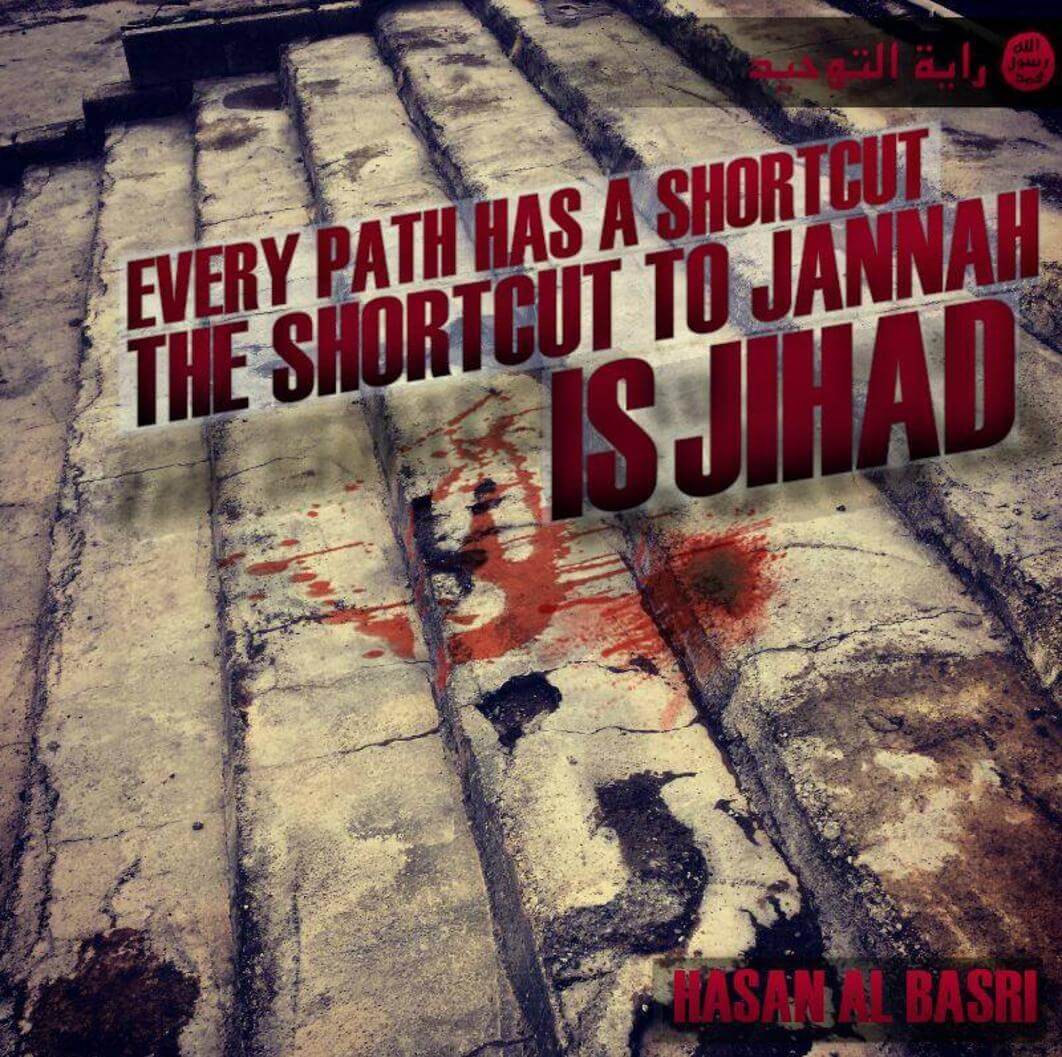
Death is also downplayed in favor of keeping eternal rewards in mind. Bird of Jannah posted a photo of a “martyred” ISIS cadre with the slogan Don’t Mourn a Martyr who Laughs, implying death in ISIS is hardly tragic when Paradise is the result.
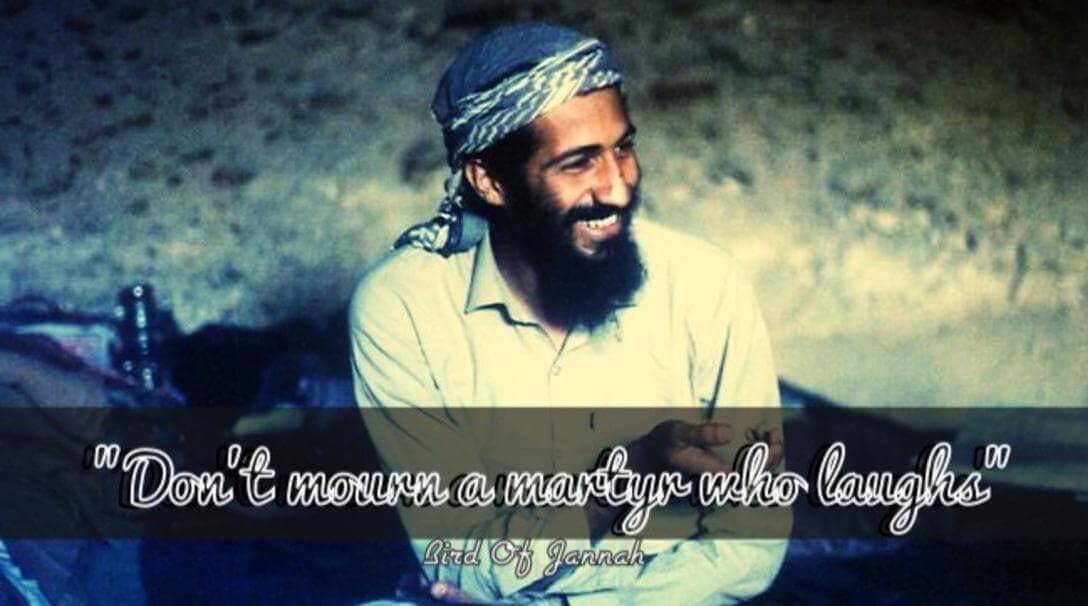
Sacrifice
In the October 2014, ISIS film, There is no Life Without Jihad, an Aberdeen Briton, first generation immigrant (originally from Bangladesh), Abu Bara’ al Hindi, asks viewers “Are you willing to sacrifice the fat job you’ve got, the big car you’ve got, the family you have? Are you willing to sacrifice this for the sake of Allah?” He goes on to reassure that Allah repays sacrifice saying, “Definitely! If you sacrifice something for Allah, Allah will give you 700 times more than this.”[12]
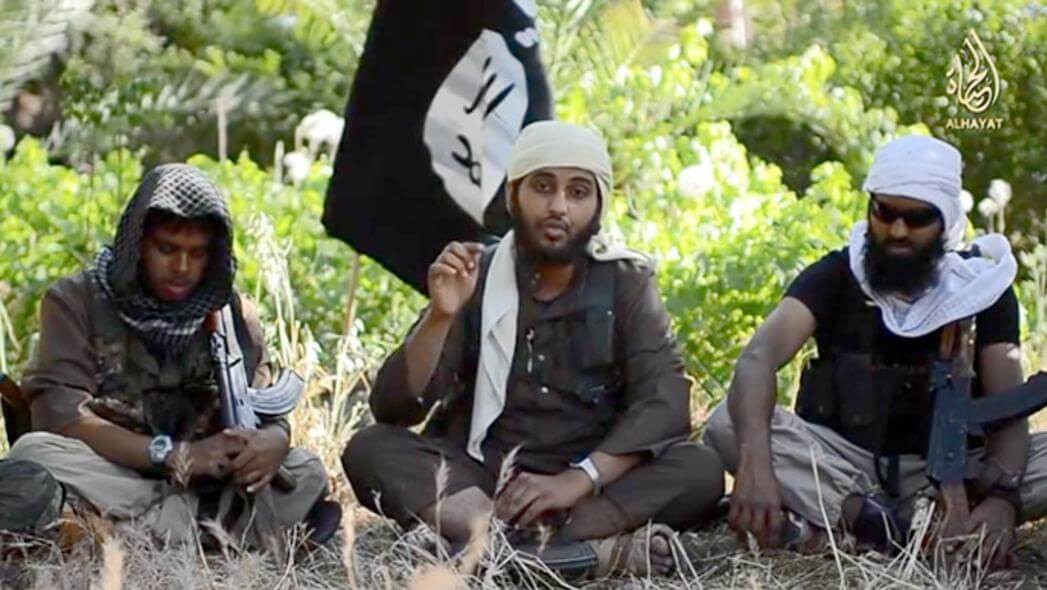
Admitting to the costs involved in pursuing militant jihad, one ISIS poster quotes the al Qaeda spiritual leader, Abu al Muhammed al Maqdasi saying, For the pleasure of a Lord, mighty and generous, the prisons come perfumed and the bitter come sweet. Maqdasi was himself imprisoned in Jordan and was the spiritual leader of Abu Musab al Zarqawi, the leader of al Qaeda in Iraq, although he later criticized Zarqawi for the hotel terrorist attacks in Jordan that indiscriminately killed Muslim civilians. He has also been critical of ISIS.

Another poster depicting an ISIS fighter standing over a destroyed, modern urban landscape while wielding an assault rifle is captioned, It Won’t be Easy, But it Will be Worth It. The city location is unclear, but the message is clear—that ISIS cadres will fight, sacrifice and be victorious over even cities with skyscrapers.

Marginalization and Discrimination
Marginalization and discrimination are social grievances that many first and second generation Muslims of immigrant descent face in Western countries, particularly in Europe and Australia. ISIS propaganda addresses that as well.
One such poster is of an ISIS fighter holding an assault rifle and is captioned, For many years they have treated us as second class, although Allah gave us honor and guidance through Islam. This idea being that Islam is the answer to finding honor when one’s social status is not adequately respected.

Interestingly, ISIS tried to appeal to poor blacks in the United States during the Ferguson and Baltimore riots with similar propaganda shown both in posters and tweets.

One poster depicts a black man bloodied by the police in Ferguson under the caption, USA, juxtaposed with a picture of two armed ISIS cadres of different races standing side by side, under the caption, Islam. Over both is the slogan, Islam is the Answer and underneath the caption, The Difference between Islam and Infidelity. The message being that if one comes to join ISIS, one will no longer face violent discrimination.
Another poster warns Never Turn your Backs to Them, reminding the viewer that Muslims need to be on the defensive, which in the jihadi mentality is turned into a militant offensive.

Depression
A 2014 film produced by al Hayat, entitled There is No Life Without Jihad, features five ISIS militants from the UK and Australia sitting in a wooded area, holding rifles with the Islamic black flag flying behind them. They call on Muslims to come fight jihad while a song playing in the background urges “the lions of God to travel to the land of Sham (Syria) and the Euphrates (Iraq)”. [13]
In the video, one of the British speakers, identified as Abu Bara al-Hindi, who is from Aberdeen, Scotland and a first generation immigrant to the UK from Bangladesh, speaks to the disillusioned and vulnerable viewer telling them, “The cure for depression is jihad.” He assures that coming to fight jihad with ISIS will make the viewer feel better, removing the sense of shame, depression, and powerlessness that many of immigrant descent struggle with in Europe. He states, “Feel the honor we are feeling, feel the happiness we are feeling.” [14] He appears alongside Nasser Muthana, a UK national, and former medical student from Cardiff who lends an air of “medical” credibility to these words about jihad being the cure for depression. [15]
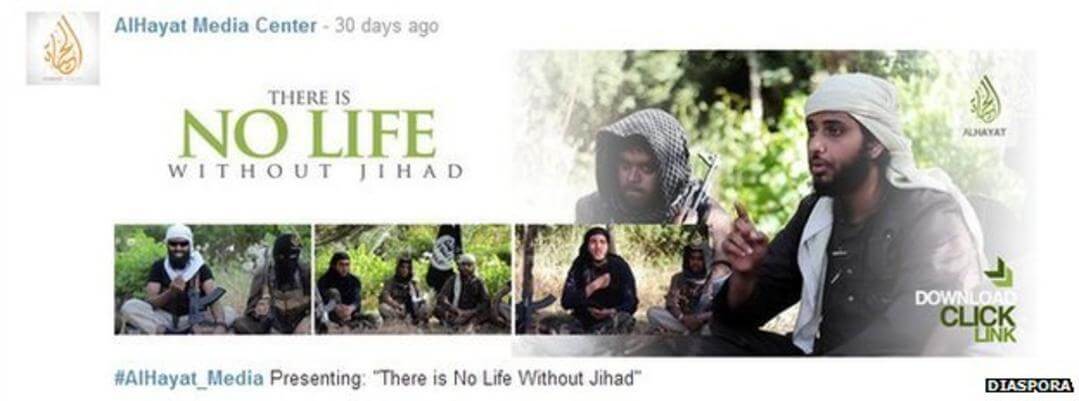
Empowerment
One poster shows an ISIS cadre holding up an assault rifle with the slogan, As Soon as we Picked up the Gun, They Started to Listen. The message is clear—without taking up arms one is silenced, but with them one is empowered.

Similarly, another poster is of a man holding an assault rifle with the simple slogan, When Deeds Speak, Words are Nothing. The message is clear—pick up arms, join the jihad, and be heard.
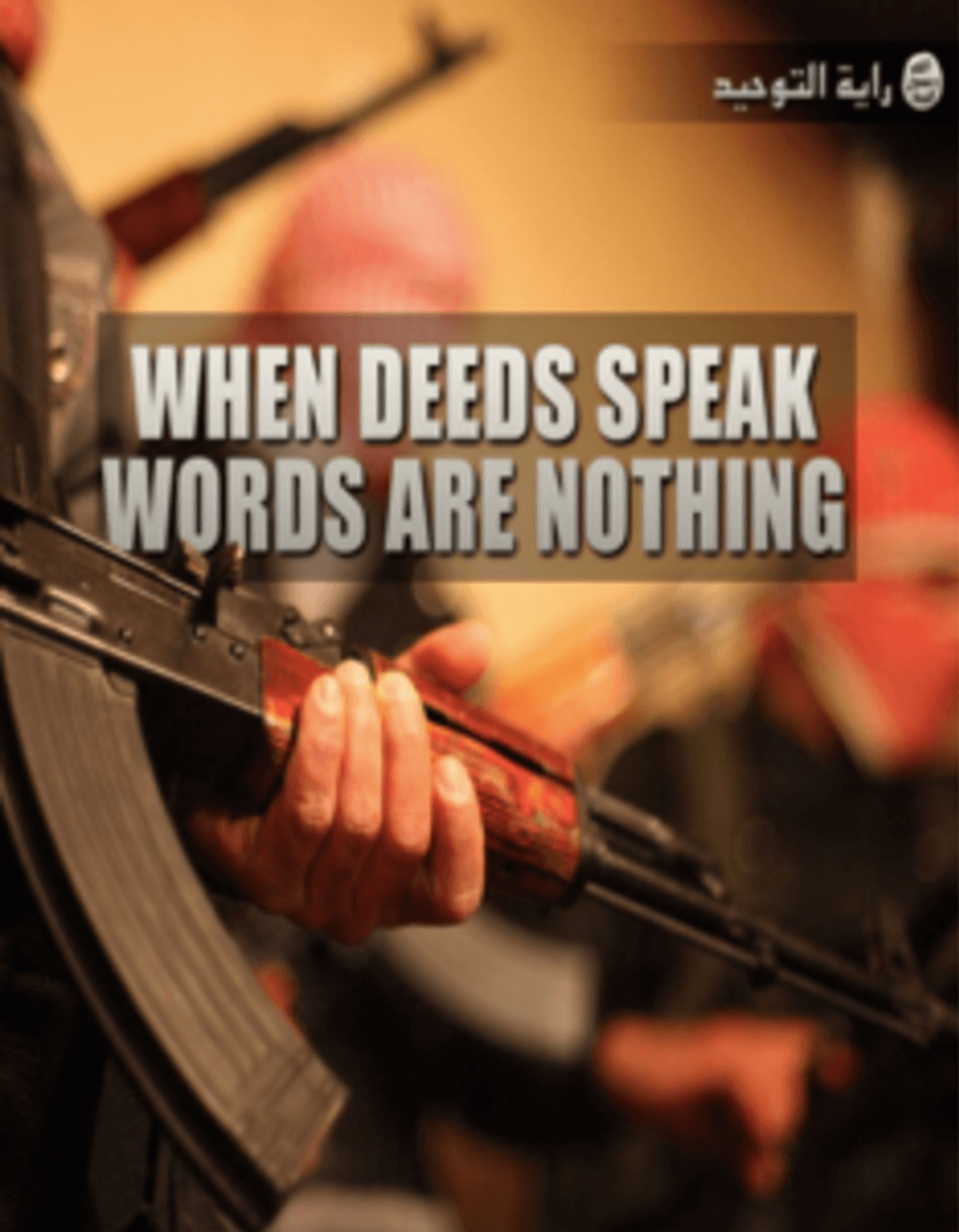
Conclusion
Clearly ISIS has mastered the art of advertising—combining images with catchy slogans in attempts to override critical thinking to market itself as a group and a lifestyle choice. Tragically with such propaganda, it has already attracted thousands of Westerners to its cause and appears likely to attract more. The messages depicted in this paper resonate with the vulnerabilities and motivations of Western youth. Using other emotionally evocative images the West needs to fight back, to delegitimize and replace these with others that do not advocate violent solutions or militant jihad as the answer, and that also address better solutions in regards to the underlying vulnerabilities of potential recruits. Until that happens however, groups like ISIS will continue to flourish in their Internet marketing campaigns.
Thank you to Allison McDowell-Smith for her comments on an Earlier Version of this paper and to Mubin Shaikh for Providing Some of the images.
Endnotes
[1] al-Awlaki, A. Constants on the path of jihad. Retrieved from: https://archive.org/details/Consta; al-Awlaki, A. (april 25, 2010). The Transcript Of “A Call To Jihad” the Unjust Media. Retrieved from: http://www.theunjustmedia.com/Islamic%20Perspectives/April10/The%20Transcript%20of%20A%20Call%20to%20Jihad%20by%20Imam%20Anwar%20al-Awlaki%20(may%20Allah%20protect%20him).htm; al-Awlaki, A. (May 1, 2009). 44 Ways of Supporting Jihad. the Unjust Media. Retrieved from: http://theunjustmedia.com/Islamic%20Perspectives/Jan09/44%20Ways%20of%20Supporting%20Jihad.htm
[2] Fernandez, A. (July 2, 2015). ISIS promotes image of building, not just destruction. Retrieved from: http://www.memri.org/report/en/0/0/0/0/0/0/8641.htm
[3] Moore, J. (November 17, 2014). ISIS: British medical student Nasser Muthana shown next to Jihadi John in Peter Kassig beheading video. International Business Times. http://www.ibtimes.co.uk/isis-british-medical-student-nasser-muthana-shown-next-jihadi-john-peter-kassig-beheading-video-1475162
[4] Becker, O. (July 12, 2014). ISIS has a really slick and sophisticated media department. Vice News. https://news.vice.com/article/isis-has-a-really-slick-and-sophisticated-media-department
[5] Speckhard, A., & Shaikh, M. (June 3, 2014). End times brewing: An apolcalyptic view on al-Baghdadi’s declaration of a caliphate in Iraq and the flow of foreign fighters coming from the West. Huffington Post. http://www.huffingtonpost.co.uk/anne-speckhard/isis-iraq_b_5541693.html
[6] Speckhard, A., & Shaikh, M. (2014). Undercover Jihadi: Inside the Toronto 18–Al Qaeda inspired, homegrown terrorism in the West: Advances Press, LLC.
[7] Hall, E. (September 17, 2014). An ISIS love story: “Till martyrdom do us part”. http://www.buzzfeed.com/ellievhall/an-isis-love-story-till-martyrdom-do-us-part#.qdoryEyjao
[8] Knight, M. M. (September 3, 2014). I understand why Westerners are joining jihadi movements like ISIS. I was almost one of them. Washington Post. https://www.washingtonpost.com/posteverything/wp/2014/09/03/i-understand-why-westerners-are-joining-the-islamic-state-i-was-almost-one-of-them/
[9] Speckhard, A., & Shaikh, M. (2014). Undercover Jihadi: Inside the Toronto 18–Al Qaeda inspired, homegrown terrorism in the West: Advances Press, LLC.
[10] See: Speckhard, A. (2012). Talking to terrorists: Understanding the psycho-social motivations of militant jihadi terrorists, mass hostage takers, suicide bombers and “martyrs”. McLean, VA: Advances Press, and Speckhard, A. (May 4, 2015). Female terrorists in ISIS, al Qaeda and 21rst century terrorism. Trends Research. https://www.academia.edu/12606010/Female_Terrorists_in_ISIS_al_Qaeda_and_21st_Century_Terrorism
[11] Speckhard, A., & Akhmedova, K. (2006). The New Chechen Jihad: Militant Wahhabism as a Radical Movement and a Source of Suicide Terrorism in Post-War Chechen Society. Democracy and Security, 2(1), 103-155.
[12] Milmo, C. (June 20, 2014). Iraq crisis: Isis video calls on British Muslims to join in jihad as ‘cure for depression’. The Independent. http://www.independent.co.uk/news/world/middle-east/iraq-crisis-isis-video-calls-on-british-muslims-to-join-in-jihad-as-cure-for-depression-9552937.html
[13] Reuters. (June 20, 2014). Australian and British jihadists urge Muslims to join jihad in Syria and Iraq in new video. New York Daily News. http://www.nydailynews.com/news/world/australian-british-jihadists-urge-muslims-join-jihad-syria-iraq-article-1.1837418
[14] Milmo, C. (June 20, 2014). Iraq crisis: Isis video calls on British Muslims to join in jihad as ‘cure for depression’. The Independent. http://www.independent.co.uk/news/world/middle-east/iraq-crisis-isis-video-calls-on-british-muslims-to-join-in-jihad-as-cure-for-depression-9552937.html
[15] Moore, J. (November 17, 2014). ISIS: British medical student Nasser Muthana shown next to Jihadi John in Peter Kassig beheading video. International Business Times. http://www.ibtimes.co.uk/isis-british-medical-student-nasser-muthana-shown-next-jihadi-john-peter-kassig-beheading-video-1475162




[…] Center for the Study of Violent Extremism. October 20, 2015. Accessed November 18, 2020. https://www.icsve.org/the-hypnotic-power-of-isis-imagery-in-recruiting-western-youth/. Vogel, Lauren. “Why Are Doctors Joining ISIS?” Canadian Medical Association […]